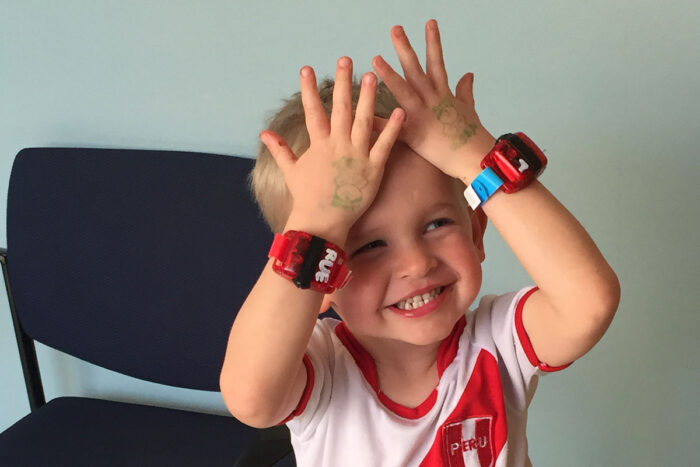Wearable Motion Detectors May Prevent Early Childhood Disabilty
A study published in JAMA Network Open has shown that wristwatch-like motion-tracking devices can help detect movement problems in children whose impairments are often overlooked. The detection of subtle motor impairments can significantly reduce the development of early childhood disability.
A child shows off a pair of motion detectors that he wore around the clock for a study on motor deficits in children. Researchers at Washington University School of Medicine in St. Louis found that wristwatch-like motion detectors can help identify in children signs of motor impairments that might otherwise be missed. Credit: WUSTL.EDU/Catherine Hoyt
"I had a teenager come into my clinic because he was trying on gloves at a sporting-goods store, and the store owner noticed he was struggling to put his baseball glove on," said senior author Nico Dosenbach, MD, PhD, an assistant professor of neurology who sees patients at St. Louis Children's Hospital. "They thought he'd hurt his elbow playing baseball. But it turned out he'd had a massive stroke as an infant that damaged the motor parts of his brain, and no one had ever noticed until the store owner said something. I sent him to therapy, but he had only partial recovery. Perhaps if we'd sent him to therapy when he was a toddler instead of a teenager, it might have made a bigger difference."
Stroke is most likely experienced during the first week of birth with as many as 1 in 1,600 babies having to go through one. The stroke can lead a child to lose control on one side of the body and the impairment may go unnoticed until years later when tasks like getting dressed, carrying bulky objects or opening a door become a challenge to many children.
Learn more about childhood stroke:
"Handedness doesn't really emerge until around age 3, so if you have an infant or toddler favoring one hand, that's not normal," said occupational therapist and graduate student Catherine Hoyt, OTD, the paper's first author. "But not everyone knows that, so parents might not think to mention it to the pediatrician, and doctors aren't likely to pick up on something that subtle in a 15-minute checkup. I was looking for a way to affordably and efficiently screen for motor deficits so we can pick up on children who would otherwise be missed and get them into therapy early."
The study used motion-tracking devices known as accelerometers that measures how much children use each arm in their daily lives. The researchers wrote an algorithm to analyze the data generated from the accelerometers which will take into account how often and how forcefully the children moved each arm, and how many of the movements were involved--both arms or just one.
"Many of the children with impairments used one arm only 60 to 80 percent as much as the other, which is really abnormal," said Dosenbach, who is also an assistant professor of occupational therapy and of pediatrics. "Even that level of impairment is not always easy for a pediatrician to detect, because children often behave totally differently in the doctor's office than they do normally."
Source: Science Daily









